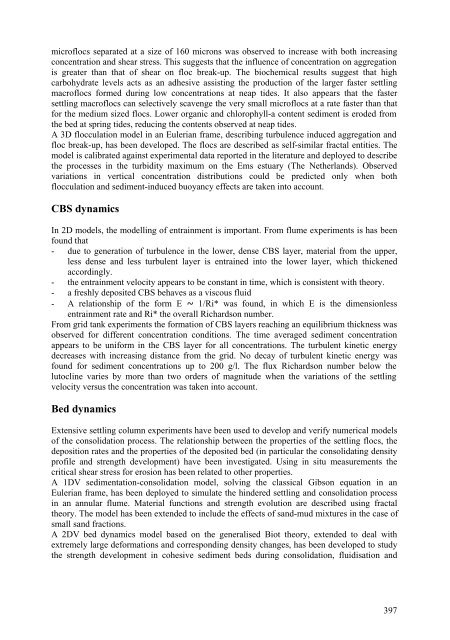EurOCEAN 2000 - Vlaams Instituut voor de Zee
EurOCEAN 2000 - Vlaams Instituut voor de Zee
EurOCEAN 2000 - Vlaams Instituut voor de Zee
Create successful ePaper yourself
Turn your PDF publications into a flip-book with our unique Google optimized e-Paper software.
microflocs separated at a size of 160 microns was observed to increase with both increasing<br />
concentration and shear stress. This suggests that the influence of concentration on aggregation<br />
is greater than that of shear on floc break-up. The biochemical results suggest that high<br />
carbohydrate levels acts as an adhesive assisting the production of the larger faster settling<br />
macroflocs formed during low concentrations at neap ti<strong>de</strong>s. It also appears that the faster<br />
settling macroflocs can selectively scavenge the very small microflocs at a rate faster than that<br />
for the medium sized flocs. Lower organic and chlorophyll-a content sediment is ero<strong>de</strong>d from<br />
the bed at spring ti<strong>de</strong>s, reducing the contents observed at neap ti<strong>de</strong>s.<br />
A 3D flocculation mo<strong>de</strong>l in an Eulerian frame, <strong>de</strong>scribing turbulence induced aggregation and<br />
floc break-up, has been <strong>de</strong>veloped. The flocs are <strong>de</strong>scribed as self-similar fractal entities. The<br />
mo<strong>de</strong>l is calibrated against experimental data reported in the literature and <strong>de</strong>ployed to <strong>de</strong>scribe<br />
the processes in the turbidity maximum on the Ems estuary (The Netherlands). Observed<br />
variations in vertical concentration distributions could be predicted only when both<br />
flocculation and sediment-induced buoyancy effects are taken into account.<br />
CBS dynamics<br />
In 2D mo<strong>de</strong>ls, the mo<strong>de</strong>lling of entrainment is important. From flume experiments is has been<br />
found that<br />
- due to generation of turbulence in the lower, <strong>de</strong>nse CBS layer, material from the upper,<br />
less <strong>de</strong>nse and less turbulent layer is entrained into the lower layer, which thickened<br />
accordingly.<br />
- the entrainment velocity appears to be constant in time, which is consistent with theory.<br />
- a freshly <strong>de</strong>posited CBS behaves as a viscous fluid<br />
- A relationship of the form E a 1/Ri* was found, in which E is the dimensionless<br />
entrainment rate and Ri* the overall Richardson number.<br />
From grid tank experiments the formation of CBS layers reaching an equilibrium thickness was<br />
observed for different concentration conditions. The time averaged sediment concentration<br />
appears to be uniform in the CBS layer for all concentrations. The turbulent kinetic energy<br />
<strong>de</strong>creases with increasing distance from the grid. No <strong>de</strong>cay of turbulent kinetic energy was<br />
found for sediment concentrations up to 200 g/l. The flux Richardson number below the<br />
lutocline varies by more than two or<strong>de</strong>rs of magnitu<strong>de</strong> when the variations of the settling<br />
velocity versus the concentration was taken into account.<br />
Bed dynamics<br />
Extensive settling column experiments have been used to <strong>de</strong>velop and verify numerical mo<strong>de</strong>ls<br />
of the consolidation process. The relationship between the properties of the settling flocs, the<br />
<strong>de</strong>position rates and the properties of the <strong>de</strong>posited bed (in particular the consolidating <strong>de</strong>nsity<br />
profile and strength <strong>de</strong>velopment) have been investigated. Using in situ measurements the<br />
critical shear stress for erosion has been related to other properties.<br />
A 1DV sedimentation-consolidation mo<strong>de</strong>l, solving the classical Gibson equation in an<br />
Eulerian frame, has been <strong>de</strong>ployed to simulate the hin<strong>de</strong>red settling and consolidation process<br />
in an annular flume. Material functions and strength evolution are <strong>de</strong>scribed using fractal<br />
theory. The mo<strong>de</strong>l has been exten<strong>de</strong>d to inclu<strong>de</strong> the effects of sand-mud mixtures in the case of<br />
small sand fractions.<br />
A 2DV bed dynamics mo<strong>de</strong>l based on the generalised Biot theory, exten<strong>de</strong>d to <strong>de</strong>al with<br />
extremely large <strong>de</strong>formations and corresponding <strong>de</strong>nsity changes, has been <strong>de</strong>veloped to study<br />
the strength <strong>de</strong>velopment in cohesive sediment beds during consolidation, fluidisation and<br />
397

















